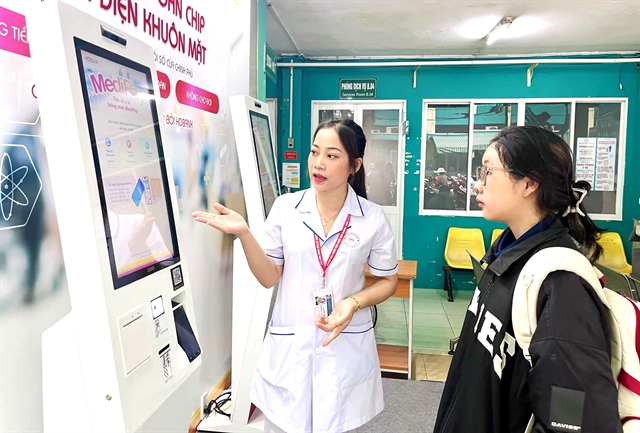HÀ NỘI ( WNAM MONITORING ): Việt Nam’s health system is accelerating its digital overhaul as hospitals expand electronic records, imaging platforms and data-sharing networks, even as funding gaps and workforce shortages continue to limit the move towards a fully unified system.
According to the Ministry of Health, all hospitals under its management now operate hospital information systems (HIS). Around 92.3 per cent use software supplied by domestic technology firms while 7.7 per cent have developed their own systems.
Laboratory information software has been installed in 92.3 per cent of those hospitals and 52.6 per cent have deployed RIS-PACS, the digital imaging and archiving system intended to replace traditional film.
Digitalisation has advanced at local levels too.
More than 99.7 per cent of medical facilities in 34 provinces and cities are connected to Vietnam Social Security’s claims-assessment system, a key requirement for streamlining reimbursements and curbing abuse.
Nationwide, 23 hospitals have fully switched to filmless diagnostic imaging. Nearly two-thirds of all medical facilities, more than 1,100 out of 1,650, have adopted electronic medical records (EMRs), cutting millions of paper files each year and reducing consultation times.
Nguyễn Lê Khuê, Deputy Director of the Ministry of Health’s Department of Science, Technology and Training, said digital-record rollout is now complete across public hospitals in a number of provinces and cities, including Hà Nội, Hải Phòng, Đà Nẵng and Thanh Hóa.
Only three ministry-run hospitals have yet to declare EMR adoption, largely because they have not completed technical acceptance procedures or secured implementation funds.
The ministry is building a national health data centre with server room standards of Tier 2 or above. Online public service portals, digital health statistics platforms and a nationwide electronic personal health record are also being rolled out in phases.
New technologies are being piloted inside hospitals. Several major facilities are testing AI-based clinical decision tools, drug-interaction alerts, chatbots for basic counselling and speech-to-text systems for clinical data entry.
Khuê said the shift is beginning to improve the speed and transparency of clinical operations, from drug-use data and consumables to bed fees and laboratory tests.
Real-time data analysis, he argued, could help health authorities issue earlier warnings during outbreaks and shape more evidence-based policy decisions.
A national-scale data set, he said, offers a clearer picture of population health and can tighten oversight of insurance-funded services, helping prevent unnecessary prescribing or overuse of diagnostics.
But progress remains uneven and often slow. Some hospital directors still treat digitalisation as a narrow IT upgrade rather than a sector-wide transformation requiring retraining, governance adjustments and long-term budgeting.
Funding is the biggest constraint, especially for provincially managed public hospitals in lower fiscal categories that rely on state budgets or limited autonomous revenues.
Local procurement continues to be a stumbling block. Many provinces report difficulties in designing, appraising and approving IT projects, and in selecting suppliers in a market where more than 18 companies offer EMR software with varying compatibility.
Hospitals also say they struggle to recruit and retain IT specialists capable of managing complex health information systems, while many clinicians and patients still lack the digital skills needed to use electronic records effectively.
Data standards are another unresolved challenge.
Trần Quý Tường, Chairman of the Vietnam Medical Informatics Association, said hospitals still store information in different formats, making interoperability a persistent headache.
He urged the \Government to move quickly on a unified national data-architecture model and set clear roadmaps for adopting AI, IoT and big-data technologies, from imaging diagnostics to chronic disease management.
Protecting privacy and sharing data safely remain sensitive issues.
Deputy Health Minister Nguyễn Tri Thức said a new decree issued in May 2025 establishes rules for managing health data but more detailed regulations will be needed to support secure data exchange between public and private providers and safeguard patient information in an increasingly digital environment.
Health Minister Đào Hồng Lan said the Government evaluates hospitals’ digital transformation progress annually, using a set of indicators that measure productivity, efficiency, operating costs, innovation and patient and business satisfaction.
Medical training institutions are assessed under a parallel system designed to push universities and colleges to modernise their curricula and technology use.
Officials argue that patients are already seeing tangible benefits: easier access to online services, smoother hospital workflows, clearer information and more transparent billing.
They also say digitalisation can reduce administrative workloads and cut operating costs at overstretched public hospitals.
Still, the ministry acknowledges that the long-term goal, a unified, interoperable nationwide digital health ecosystem, will require sustained investment, a stronger legal framework and leadership buy-in across all hospital tiers.
The next phase, they say, will be defined less by the technology itself and more by whether hospitals can adopt it consistently, securely and in ways that improve care for patients.


